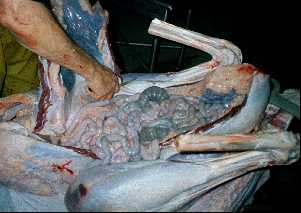
Photo 1 - The "Fat Pan" Being Removed

Most
every animal has some method for fat storage that can be used in times
of stress, illness, high production, or severe weather. Ostriches have
small amounts of fat here and there all around and in their body, but
the main FAT RESERVE that they can easily draw from, when needed, is
all in one place located on their belly starting from just in front of
the legs and extending all the way to the rear under the body. Blue
Mountain has named this area the FAT PAN for clarity purposes.
Photo 1 shows the fat pan being removed from the carcass. As the photo
clearly shows, the fat pan sets over the intestinal cavity and acts
also as a cushion for same. The fat pan is a slab of fat covered on
both sides by a "grayskin" that is very tough and slick--similar to the
skin of a catfish (and just about as hard to remove from the fat pan).
Photo 2 - Perfect Color & Thickness of Fat Pan
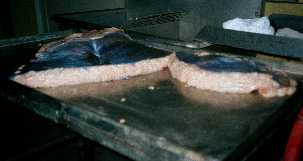
Photo 2
a nearly perfect Fat Pan from a Blue Mountain fed bird. For
demonstation purposes, this fat pan was cut in half with a knife, then
spread open to display the inside.
This fat pan came from a 12 month old bird yielding a PRIME GRADE
carcass with excellent muscle growth and high quality meat. It is most
clear that all Ostrich need a certain amount of good fat reserve in
order to function properly at all times of the year.
As said earlier, the fat pan is a slab of fat covered on both sides by
grayskin. There are two things to look for on the fat pan that can
easily be used as indicators for proper bird nutrition:
1. The
COLOR of the fat inside the fat pan is most crucial. It should be WHITE
and not yellow or dark yellow. White fat mobilizes easily in times of
stress, high production, illness, or severe weather. Yellow fat is very
course and "bound" making it most difficult for the bird to easily
utilize it when needed.
2. The THICKNESS of the fat pan is also most crucial. The fat pan in
Photo 2 is about 1-1/4 inches (3.2 centimeters) thick which is PERFECT
for a bird this age. This thickness indicates the feeding program is
adequate and the feeding management is first class. This thickness will
get the bird through almost any stress, illness, high production, or
severe weather without being totally depleted--especially if the bird
experiences two major stresses in a short period of time.
Photo 3 - Incorrect Color & Thickness of Fat Pan
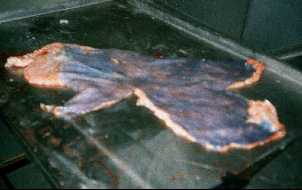
Photo 3
shows a fat pan from a bird that was about to be in serious trouble.
There is hardly any fat between the grayskins--it actually measured
about 1/4 inch (6.4 millimeters) in thickness. The fat is very yellow
in color.
This amount of fat in the fat pan is not enough for the bird to
metabolize in times of stress, illness, high production, or severe
weather. The bird may get through a time of slight stress (like a cold
weather spell) but if another stress comes along, the bird will DIE of
starvation even though it is being fed feed everyday.
This problem (or syndrome) is MOST COMMON in the industry. When adult
and adolescent birds are dying for no obvious reason during times of
stress, the problem can usually be found in the fat pan with it showing
no reserves of fat left as in this photo.
This problem also shows up in Breeder birds on poor feeding programs.
Without the fat pan reserve that should be built up during the "off
season", breeder birds cannot be high production birds. Males will not
have the energy needed for high breeding activity, females cannot "call
up" the extra energy needed for high egg production. The fat pan
reserve amount is most crucial to productive breeding ostrich.
The "fat soluble" vitamins A, D, E, and K are also stored in the Fat
Pan reserve. These vitamins are most important to growth, fertility,
and chick survivability by yolk nutrient transfer from the hen. If
there is NO fat pan reserve, there also is NO vitamin reserve for the
bird to use when it needs it most--like during high egg production.
This syndrome occurs most commonly during the last half of the egg
laying year on hens fed a improper diet causing the "tail end" chicks
to be stunted and very hard to raise.
Photo 4 - Fat Pan, Correct Color--Too Thick
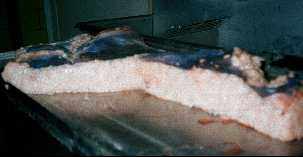
Photo 4
shows a fat pan cut in half with a knife. The fat color is an excellent
white, but the thickness is nearly 2 inches (5 centimeters) thick.
While this thickness is not a terrible situation, it indicates that the
bird is slightly over-fat meaning the feeding management probably needs
some attention (bird was over-fed).
However, this condition is still far better than starving the bird to a
NO FAT condition. This thickness could also be a indication that the
feed formula is too high in protein or energy for this bird. In some
manner, the bird is getting slightly too much of something.
Photo 5 - Incorrect Fat Pan Color & Thickness
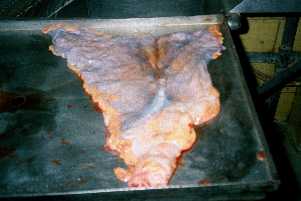
The fat
pan in Photo 5 was taken off a non-producing Ostrich hen that was about
6 years of age. By this point, it should be obvious to you WHY this hen
was not producing. It was so deficient of nutrients with the yellow fat
and there was absolutely no fat reserve for the bird to draw from to
produce eggs--it was starving and just trying to remain alive. It most
likely would have died in the coming winter months as this bird was
from a very cold climate in the wintertime.
It requires extra energy for the bird to survive through stressful
times. The "extra" energy source the bird uses frequently is the fat
pan. If the fat reserve in the fat pan is non-existent, the bird
immediately is faced with another stress during an already stressful
period--malnutrition.
Photo 6 - Fat Pan, Correct Color, Too Thick
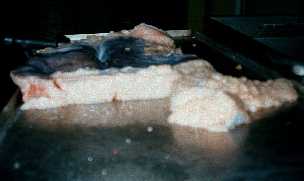
The fat
pan in Photo 6 is of very good color but is thicker than it needs to
be. This one measured about 2-1/4 inches (5.7 centimeters). Since this
fat pan came from a bird that was 12 months of age, it indicates an
over-fed condition and some dollars could have been saved on feed
costs. Otherwise, the fat pan is excellent and the meat from this bird
will be PRIME GRADE ostrich meat.
On Breeder birds, sometimes the fat pan can be as thick as 4 or 5
inches (10-13 centimeters). This much fat reserve in the fat pan would
classify this breeder bird as "obese". Obese breeder birds usually also
have extra fat in and around organs also causing production problems
and fertility difficulties in males. An overly fat breeder bird causes
poor breeding and egg laying--but they do need an adequate amount of
fat in the fat pan to be PRODUCTIVE.
Obese breeder bird problems that cause "non-productive" birds can
usually be solved by re-evaluating the feed formulas and the feeding
management pratices and then implementing the changes. However, once
the feed formulas and feeding management is correct, it may take as
long as two years to get the breeder bird productive again.
Copyright© of Blue Mountain all rights reserved